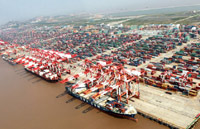China eyes sustainable, strong agriculture
(Xinhua) Updated: 2015-02-04 10:46BEIJING - Despite old land and unfavorable weather, farmer Xu Jianmin managed to double his harvest in Central China last year, in some cases increasing the value of produce 10 fold.
The 40-year-old farmer amassed a sprawling 3,300 mu (220 hectares) of farmland in Henan Province, a region that produces one-tenth of the country's total grain output, after working with locals to transfer land use contracts.
Overhauling waterlogged ground using modern equipment and hiring professional consultants, he increased the grain yield to 600 kilograms per mu last year and sold organic vegetables at a much higher price.
"I wish I could build more farms across the country and bring my products to overseas markets," Xu said.
Xu's modern farm is not an isolated case in China.
With the new drive to steer agriculture on a sustainable path, the country has seen an increasing number of high-productivity farms.
The "No 1 Central Document", recently published by the central government, outlines their goal to accelerate the transformation of agricultural development to build a strong and modernized industry.
Green,green industry
China should develop agriculture with a balanced emphasis on quality and quantity instead of pursuing high output at the cost of resource depletion, the document says.
Riding on a wave of reforms and the country's opening up, agriculture has boomed since 1978, with grain output on an unyielding rise. China's grain output grew 0.9 percent year on year to 607.1 million tons in 2014, marking 11 years in a row of growth.
The nation also prides itself on feeding more than a fifth of the world's population on only 10 percent of arable land worldwide, despite water scarcity and scattered fertile land.
However, this commendable feat now faces grave challenges.
Experts point out that behind the surging crop yields is an excessive reliance on pesticides and chemical fertilizers. National chemical fertilizer use amounts to around a third of the world's total consumption. Chinese farmers apply 70 percent more chemicals to crops than the world average.
- Music industry fights online piracy, calls for paid services
- Growth to slow for China's smart devices: IDC forecasts
- Free patents to shake up fuel cell car sector
- China, Niger vowing deepened cooperation
- China capital account deficit widens in Q4
- Report reveals auto world's innovation trends
- China Eastern to launch new trans-Pacific flight
- New direct flight links Kunming with Thailand's Krabi
















